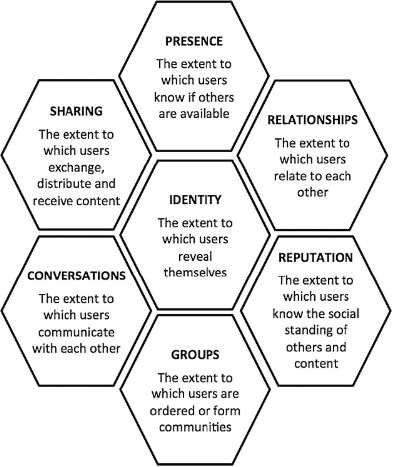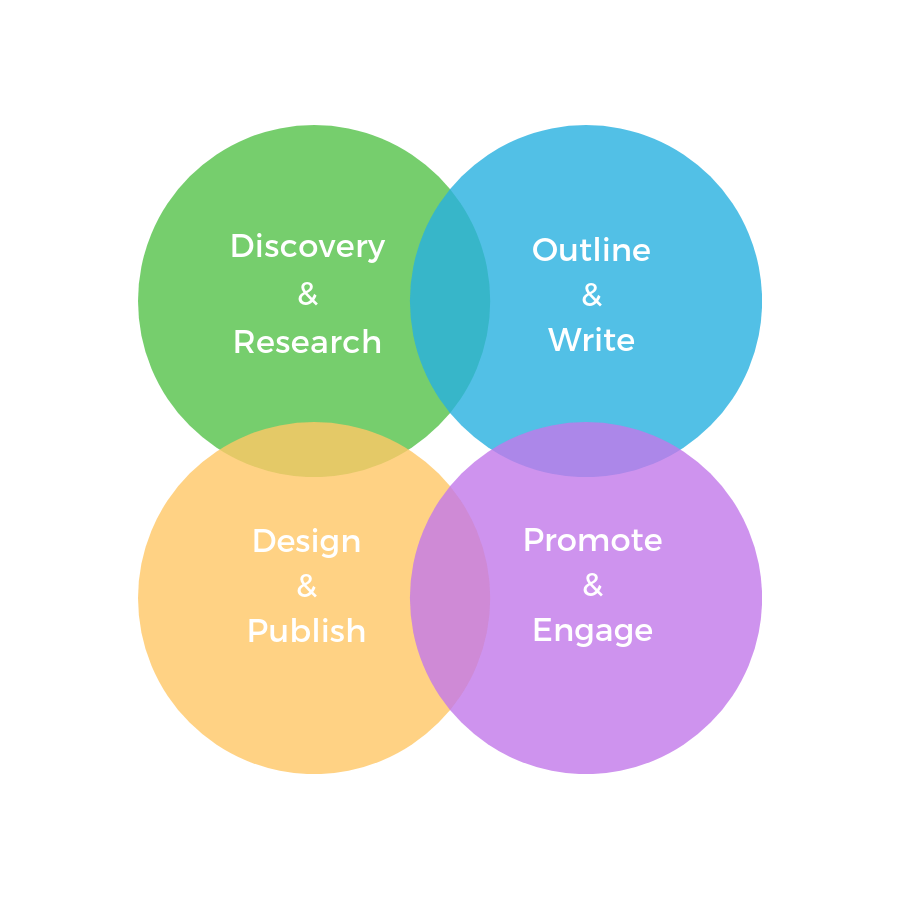Employee engagement on social media, who needs it, right. In an era defined by having “influencers” for everything (including SugarBearHair gummies — yes, even candy “vitamins” have influencers) and an abundance of user-generated content (UGC) for all to consume, who needs employees to share in the frenzy of likes, comments, shares and follows?
Every. Single. Organization. That’s who. Why? Because it helps build thought leadership — influence.
To build a stronger case, let’s first ground the previous statement in communication theory, something every professional can use as a reference point. The honeycomb framework (introduced to the communication field during the evolution of web 2.0.) enhanced modern research on public affairs, social media marketing, and online communities.
The seven blocks that compose the framework, in which social media functions are analyzed in detail, help managers understand how firms should engage with social media and link their actions with the different aspects of the social media user experience.
The seven building blocks also rationalize how each social media channel is used most effectively, influencing how a firm interacts with and cultivates specific communities of people (e.g., followers), all of which add to crating thought leadership for an organization. (For a detailed analysis of what each block entails, please reference the honeycomb framework explained in: Unpacking the social media phenomenon: towards a research agenda published by the Wiley Online Library.)
The diagram below summarizes each of the seven blocks within the honeycomb framework.

Social Media Relevance
The honeycomb framework (pictured above) guides communication professionals in analyzing the role employees play in driving successful outcomes for firms’ social media marketing. Similar to the discovery phase of a design project, this model guides practitioners by presenting the right questions to ask before forming goals and strategies. For example, the relationship block helps to define an appropriate interaction environment for companies and users, including design elements such as privacy controls, message types, connection behavior, introductions, and information prioritization. Additionally, this framework enables managers to determine how consumers (e.g., customers and clients) will respond to specific influencer groups, be it an ambassador or employee.
The honeycomb framework also highlights reputation as a tool for building trust with users on social media. Specifically, ‘individuals can’t draw from enough personal historical data for such predictions; the reputation of other individuals, of a firm or a product, is a socially shaped opinion based on aggregate experiences, shared through word of mouth, coverage in the popular press and so on.’ Simply put, building relationships on social media is about how you build trust with the end-user.
Turning Theory Into Practice
From both a relationship management and branding perspective (and learning from the reputation, relationship blocks), The Carrera Agency introduced tactical employee engagement into the communication mix over the past twelve months, a vital component of the current social media strategy: building thought leadership with valuable content. To understand how our actions could influence positive engagement and community development on LinkedIn, the team looked to the honeycomb framework for affirmation.
Here’s what we found: The act of sharing is associated with particular linkages between people, for example, a similar line of work, complementary professional roles, and common employers. In most simple terms, to engage on social media (LinkedIn), management had to first identify linkage to shared interests among users and the company. For Carrera, niche projects, personalized content, and endorsement from the experienced talent team was the answer. These three factors speak to the intrinsic and extrinsic motivations of [the company’s] end users and continue to serve as the foundation for relationship building on key channels.
How Content Influences Thought Leadership
The strategic use of content on social media creates thought leadership: the act of educating, influencing, and innovating. Within IT talent management, many people we interface with have significant experience and expertise. Still, unless this knowledge is organized in a well-articulated manner, it remains buried within the company. We intend to bring it to the surface, share it, and, in return, learn from others doing the same. We may be a small company in a large industry, but this allows us to remain focused on engaging the right people, individually providing the personal touch one should expect from an agency.
Unique to the way we approach finding the right people for the right projects, talent managers at Carrera have completed lengthy careers in different IT functions, forming a well-balanced team that understands the nuances of consulting — being a consultant.
So what does all of this have to do with how content influences the company? Well, as a boutique firm with a senior-level team, Carrera needed a way to leverage the many intangibles that currently position the agency as the right partner for larger organizations and active consultants; it needed a conduit for strategic messaging and knowledge sharing. Curated content pieces were the answer, and this has galvanized the entire team, cultivating a buy-in for creating thought leadership within our niche.
Embracing the planning, creation, and sharing of in-house, organic content to create thought leadership, single-handedly catalyzed a mindset shift in how the agency approached social media and business growth.
In essence, the content empowers employees to analyze their work and craft thoughts to benefit our target audience. The content opens the door to discovery and exploration of new trends and emerging topics within the industry, and it’s the content that inspires the team to have a clear voice and cohesive brand presence when interacting with all stakeholders.
Social Media in the Current Business Environment
As HubSpot hinted at in their article Unleashing the Power of Employees in 4 Steps, social media enables firms to do more with less. Internal teams desire more control over creating favorable outcomes. When done strategically, social media provides the autonomy we crave. Of course, this level of control increases the responsibilities of managers. Decision-makers need to conduct proper research and thoroughly understand both internal and external environments before introducing the policy. This is why the honeycomb framework exists, and why it’s a reference to scholarly communication theory holds value in the real world.
Success with this concept reinforces our commitment to thought leadership and brand advocacy among employees. As HubSpot explained so well, ‘brand advocacy allows businesses’ to drive active employee participation and leverage the internal skill set, industry, and company knowledge to generate and distribute content.’ This belief allows Carrera employees to connect their personal and professional presence on social media, creating a greater sense of purpose among a small distributed team. Everyone has a voice, shares in the process, and therefore feels responsible for positive results.
Equally important as facilitating internal engagement, employee brand advocacy increases transparency, builds brand awareness, strengthens brand image, and drives to brand equity. And to be honest, it’s conducive to every business environment. No matter the end user, consistent and cohesive communication from internal teams (on social media) positively influences the level of engagement as well as the tone used with a firm from those on the outside.
Our experiences show that education and guidelines are most important to a successful employee brand advocacy program. (Don’t be intimidated by the word ‘program;’ think process.) Depending on the size of a firm, the process can involve as many – or few – people as necessary for approval. Here’s what our process looks like:

Lastly, in the current business environment, the success of employee brand advocacy (and therefore, thought leadership) is linked to providing staff with sharable content and recognition for participation. Yes, this means people want to be rewarded for their actions, even if it’s verbal.
At the Carrera Agency, the vast majority of the content written covers specific business trends pertinent to daily operations and is disseminated on one key channel: LinkedIn. To increase efficiency, employees receive an email containing the final (tested) link to published content, copy options (if they wish to repost), and supplemental hashtags to use. This ensures minimal moving parts and keeps each advocate focused on one channel at a time.
NOTE: We have reduced the amount of error by engaging all employees involved in the sharing process at the same time. When it’s time to post a new article to LinkedIn, an email is sent with the link, image, copy, and hashtags. Simultaneously, the content manager remains on-the-line (Google chat, Slack, and LinkedIn) ready to diagnose issues and correct errors at a moment’s notice, reducing risk and fear, and encouraging quality collaboration among the team.
Employee Advocacy and Social Media
Through leveraging employee advocacy, The Carrera Agency has generated triple-digit growth on social media. But this isn’t a sales pitch; it’s a testament to the positive influence internal teams (employees) have on social media growth strategies when they are engaged, informed, and rewarded. However, beyond the act of cultivating advocacy from the best spokespersons a firm has (it’s people), managers should dig deeper to understand why their ideas could work and how they might implement them.
Communication theory offers support in this search for answers, especially in the realm of social media in the modern business environment. From our core business to main communication channels, one factor remains paramount: people. Whether it’s finding the right project for an IT consultant, or working with a client to identify their project needs, a dedication to the human element keeps us feeling good, feeling motivated. Join us and see what we are talking about today.
